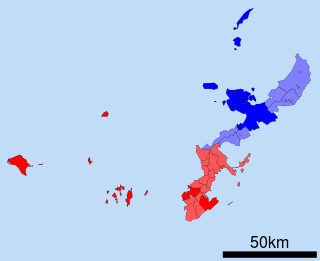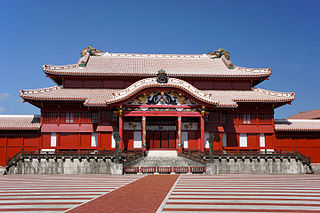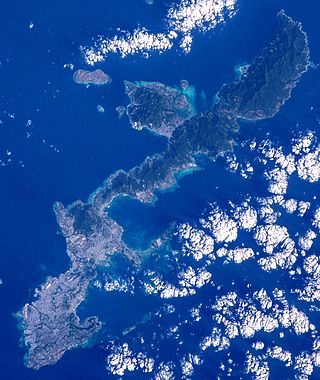
Okinawa Prefecture is the southernmost and westernmost prefecture of Japan. It has a population of 1,457,162 and a geographic area of 2,281 km2.

The Ryukyuans are a Japonic-speaking East Asian ethnic group indigenous to the Ryukyu Islands, which stretch from the island of Kyushu to the island of Taiwan. Administratively, the majority live in either Okinawa Prefecture or Kagoshima Prefecture within Japan. They speak one of the Ryukyuan languages, considered to be one of the two branches of the Japonic language family, the other being Japanese and its dialects.

Okinawan, or more precisely Central Okinawan, is a Northern Ryukyuan language spoken primarily in the southern half of the island of Okinawa, as well as in the surrounding islands of Kerama, Kumejima, Tonaki, Aguni and a number of smaller peripheral islands. Central Okinawan distinguishes itself from the speech of Northern Okinawa, which is classified independently as the Kunigami language. Both languages are listed by UNESCO as endangered.

The Japanese diaspora and its individual members, known as Nikkei or as Nikkeijin, comprise the Japanese emigrants from Japan residing in a country outside Japan. Emigration from Japan was recorded as early as the 15th century to the Philippines, but did not become a mass phenomenon until the Meiji period (1868–1912), when Japanese emigrated to the Philippines and to the Americas. There was significant emigration to the territories of the Empire of Japan during the period of Japanese colonial expansion (1875–1945); however, most of these emigrants repatriated to Japan after the 1945 surrender of Japan ended World War II in Asia.

The Ryukyuan languages, also Lewchewan or Luchuan, are the indigenous languages of the Ryukyu Islands, the southernmost part of the Japanese archipelago. Along with the Japanese language and the Hachijō language, they make up the Japonic language family.

This article is about the history of the Ryukyu Islands, located southwest of the main islands of Japan.

The Ryukyu Kingdom was a kingdom in the Ryukyu Islands from 1429 to 1879. It was ruled as a tributary state of imperial Ming China by the Ryukyuan monarchy, who unified Okinawa Island to end the Sanzan period, and extended the kingdom to the Amami Islands and Sakishima Islands. The Ryukyu Kingdom played a central role in the maritime trade networks of medieval East Asia and Southeast Asia despite its small size. The Ryukyu Kingdom became a vassal state of the Satsuma Domain of Japan after the invasion of Ryukyu in 1609 but retained de jure independence until it was transformed into the Ryukyu Domain by the Empire of Japan in 1872. The Ryukyu Kingdom was formally annexed and dissolved by Japan in 1879 to form Okinawa Prefecture, and the Ryukyuan monarchy was integrated into the new Japanese nobility.

Okinawa Island, officially Okinawa Main Island, is the largest of the Okinawa Islands and the Ryukyu (Nansei) Islands of Japan in the Kyushu region. It is the smallest and least populated of the five main islands of Japan. The island is approximately 106 kilometres (66 mi) long, an average 11 kilometres (7 mi) wide, and has an area of 1,206.98 square kilometers (466.02 sq mi). It is roughly 640 kilometres south of the main island of Kyushu and the rest of Japan. It is 500 km northeast of Taiwan. The total population of Okinawa Island is 1,384,762. The greater Naha area has roughly 800,000 residents, while the city itself has about 320,000 people. Naha is the seat of Okinawa Prefecture on the southwestern part of Okinawa Island. Okinawa has a humid subtropical climate.

The Japanese in Hawaii are the second largest ethnic group in Hawaii. At their height in 1920, they constituted 43% of Hawaii's population. They now number about 16.7% of the islands' population, according to the 2000 U.S. Census. The U.S. Census categorizes mixed-race individuals separately, so the proportion of people with some Japanese ancestry is likely much larger.

Naha is the capital city of Okinawa Prefecture, the southernmost prefecture of Japan. As of 1 June 2019, the city has an estimated population of 317,405 and a population density of 7,939 people per km2. The total area is 39.98 km2 (15.44 sq mi).
The Ryukyu independence movement is a separatist movement in Japan advocating the independence of the Ryukyu Islands. Some support the restoration of the Ryukyu Kingdom, while others advocate the establishment of a Republic of the Ryukyus.
Tatsuhiro Ōshiro was an Okinawan novelist and playwright from Okinawa, Ryukyu Islands.
The Yuan, Ming and Qing emperors of China intermittently sent diplomatic missions to Shuri, Okinawa, in the Ryukyu Islands. These diplomatic contacts were within the Sinocentric system of bilateral and multinational relationships in the Sinosphere. Some missions were sent to perform investiture ceremonies for the King of Ryukyu, formally acknowledging him as King on behalf of the Chinese Imperial Court, and as a tributary subordinate.
Most early Asian settlers to the United States, particularly the Japanese, went to Hawaii. Most of these early immigrants moved to the islands as laborers to work on the pineapple, coconut, and sugarcane plantations. These early migrants have tended to stay, although a handful returned to their home countries. Most people in Hawaii of Asian ancestry/origin are Filipino, Japanese, or Chinese. There has also been recent immigration to Hawaii from more ethnic Asian groups, including Thai, Indian, Indonesian, and Vietnamese.
Okinawans in Hawaii number between 45,000 to 50,000 people, or 3% of the U.S. state's total population.
Ryukyuan assimilation policies are a series of practices aimed at the Ryukyuan people with the intent of assimilating them into Japanese culture and identity beginning shortly before the Disposition of Ryukyu in 1879 and continuing to the present day.

Kyuzo Toyama was an Okinawan political activist. He is commonly referred to as the "father of Okinawan emigration" due to his work in sending Okinawans abroad.
Ryukyuan culture are the cultural elements of the indigenous Ryukyuan people, an ethnic group native to Okinawa Prefecture and parts of Kagoshima Prefecture in southwestern Japan.

The foreign relations of the Ryukyu Kingdom were shaped through heavy mutual contact and trade with surrounding nations, most notably Japan and China. The influence exerted by both of these nations differ throughout each era of Ryukyuan history. To a lesser extent, other nations played a role in Ryukyuan diplomacy.

The flag of Okinawa Prefecture is a white field charged in the center with the prefectural emblem, which consists of three circles stacked on top of each other. The two inner circles are positioned upwards; the outermost and innermost circles are red and the middle circle is white. The emblem was adopted on May 15, 1972, when the United States ended its administration of the Ryukyu Islands and returned Okinawa Prefecture to Japan. The flag was adopted shortly afterwards on October 13, 1972.












